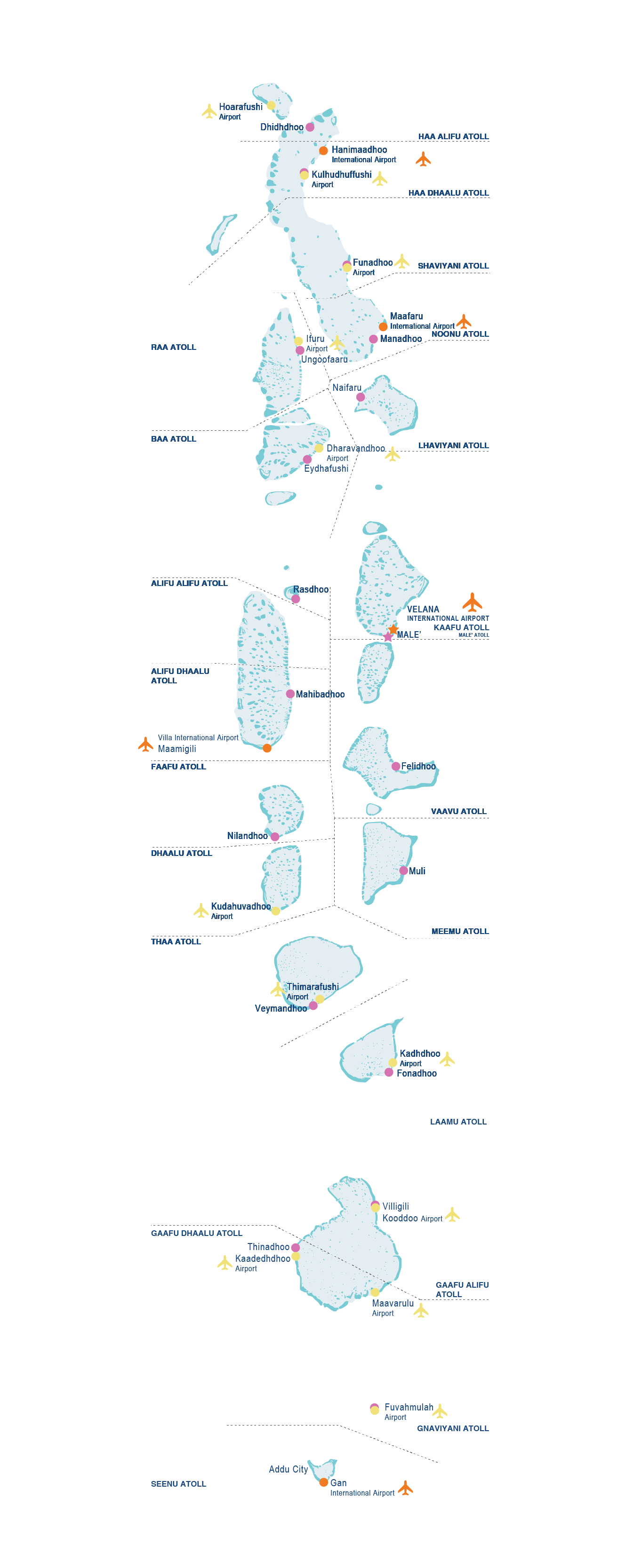Our unique geography
A nation of 1192 islands located in the Indian Ocean, the chain of atolls that make up the Maldives stretches across the equator along a length of 871 kilometres. The islands are made up entirely of coral reefs. The islands are grouped into 26 natural atolls and are divided into 20 administrative divisions.
Only 188 islands are inhabited, and over 160 are tourist resorts in operation and some of the islands are used for industry and agriculture.
Environment
The Maldives enjoys some of the richest marine biodiversity anywhere in the world. The country’s coral reefs, representing some 5% of the global reef area, are home to 250 species of coral and over 1,000 species of fish.
Several marine species and birds are protected by law. Protected areas have been designated to ensure the conservation of specific ecosystems and the rich biodiversity of the country.
Climate
The Maldives has a tropical monsoon climate with two seasons dominating the weather: the northeast monsoon from December to mid-May bringing in dry weather and the rainy season associated with the southwest monsoon from mid-May to November.
Male’, the capital
Male’ is the capital of Maldives and the seat of government. The Greater Male’ Region consisting of Male’, Hulhumale’ and Villingili is home to more than a third of the population and is the hub of the country’s economy.
International and domestic connectivity
International
Maldives is just an hour by air from Colombo and Trivandrum, India, and approximately four hours from Singapore, Kuala Lumpur and Dubai. The country is well connected with the world, with several flights being operated daily from the major cities in Europe and Southeast Asia.
Inter-atoll and intra atoll ferries
The inhabited islands of the country are connected by inter-atoll and intra-atoll public ferry services and by privately operated speedboat services. Private speed ferries also operate scheduled trips to islands in Male’ Atoll directly from Velana International Airport.
Seaplanes
Maldives is home to one of the largest seaplane fleets in the world. Well-organized and scheduled seaplane operations provide efficient and convenient transfers to resort islands outside Male’ Atoll.
Domestic air transport
Several domestic airports distributed along the length of the country offer easy access to all parts of the country

Key Economic sectors
The livelihood of Maldivians traditionally depended on the seas, fishery being the main source of sustenance. While fishery still contributes significantly to the economy in terms of employment and income, tourism contributes more than a quarter of the GDP.
GDP growth rate was 8 percent in 2018, and an estimated 7 percent in 2019. The economy is mainly driven by the tourism sector, construction, transport and communication, and real estate sectors. Economic growth is forecasted to reach an impressive 13% in 2021 due to the strong recovery from the Covid-19 pandemic.
Economic policy framework
Maldives economic policy framework is founded on four pillars: our blue economy, decentralization, resilience and pro-market policies.
Blue economy
The country’s economy and the well-being of its people are dependent on its natural environment, primarily the ocean. The largest contributors to the economy, tourism and fisheries sectors are highly dependent on the health of the ocean, coral reefs, beaches and marine life. The concept of blue economy takes this reality as the basis for delivering sustainable and inclusive growth.
Decentralization
The decentralization theme focuses on the creation of regional and sub-regional hubs, local governance autonomy and improved connectivity between the islands.
Decentralization is an important part of the government’s policy to achieve equity and sustainability. Effective decentralization has been initiated with local governance reform empowering local councils in terms of fiscal measures and authority and autonomy in devising policies.
Resilience
Our economic policy framework calls for diversification to build in greater resilience in the economy. Areas for development include transport and maritime services and achieving greater diversification through the development of industrial zones. The development of strategic infrastructure such as airports, port and logistic hubs to boost economic activity and measures to tap into new economic sectors are part of the diversification drive.
Steps are being taken to broaden the economic base through diversification and by providing greater opportunities for youth, through the development of small and medium enterprises.
Pro-market
The country’s economic objectives are being achieved through the establishment of an enhanced pro market environment with multiple vehicles for investment. This includes legislative reform, continuous review and improvement of processes for investors and increasing partnerships for promoting investments and trade.